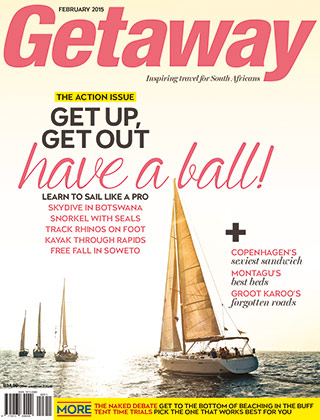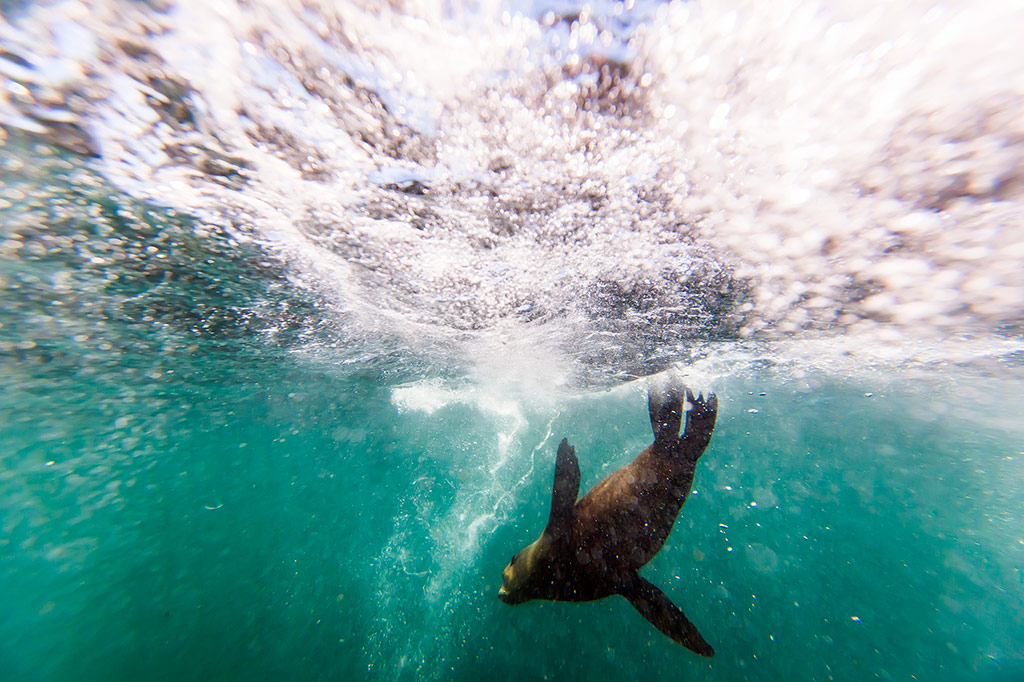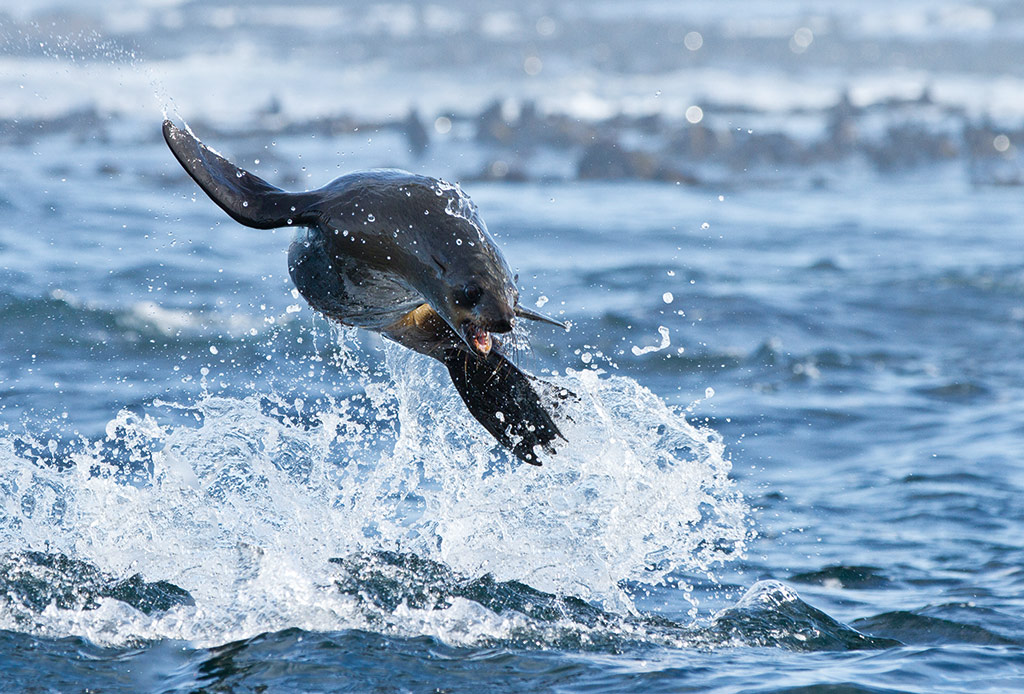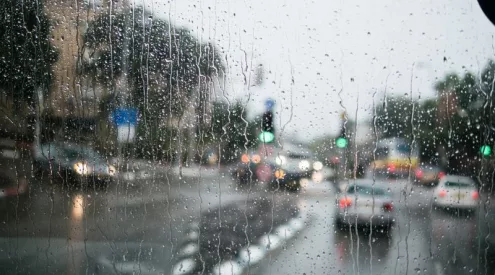Thrill seekers come to the cold Cape waters to see great whites, but the growing popularity of swimming with seals is giving sharks a run for their tourist money.
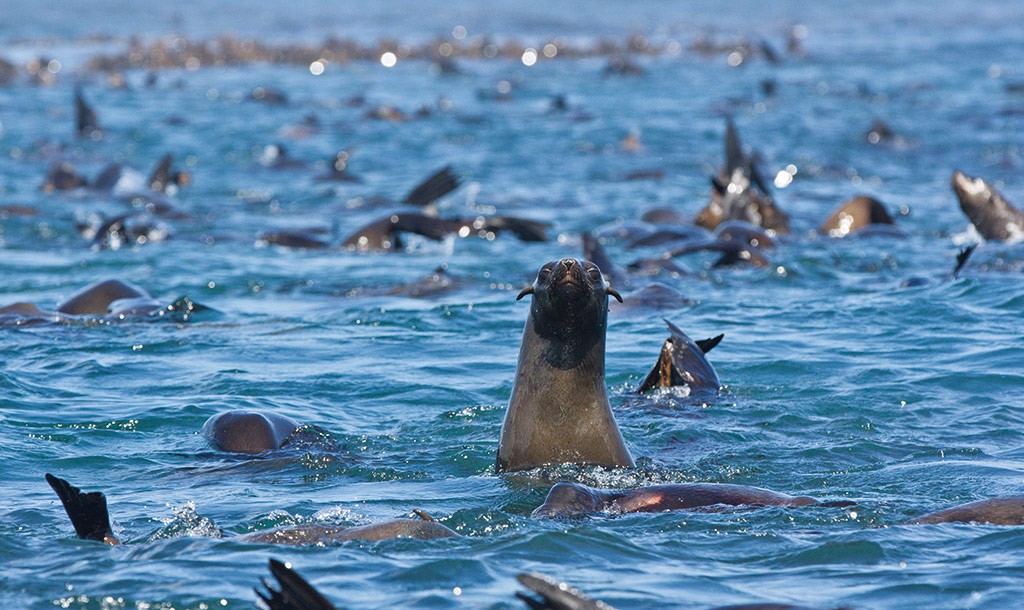
Photo by Steve Benjamin.
Above water, Cape Fur seals are a hot mess. Cumbersome, rowdy, obnoxious and generally inept they lumber across land like evolution’s leftover broccoli. Their stench fills our nostrils as we round the northern tip of Duiker Island off Cape Town’s Hout Bay. It takes some time to distinguish the blubber from the boulders, but when we near the rocky outcrop we hear hoarse barking. The land is alive and heaving with over 10000 seals baking among the rocks – and hot damn it sure smells like it. The smell comes mainly from fishy excrement, as well as the occasional dead seal pup (the poor little things can’t swim for about six months and often drown when they get knocked off the rocks). This is the low point of my trip, and as low points go I’ll take 150 stinky ones if they’re all followed by an hour of carefree carousing with Hout Bay’s sea dogs.
Cape fur seals are fast, excellent hunters who enjoy a fish dinner, but on land they’re clumsy and slow, propelling themselves forward in an inelegant, loping fashion. It goes without saying that they are at their best in the water. The ocean is a seal’s superhero serum, transforming them from gawky to graceful as they spin lazily in the laps of soft waves. I’m here to snorkel with them, which provides me with a front-row seat to their underwater acrobatics.
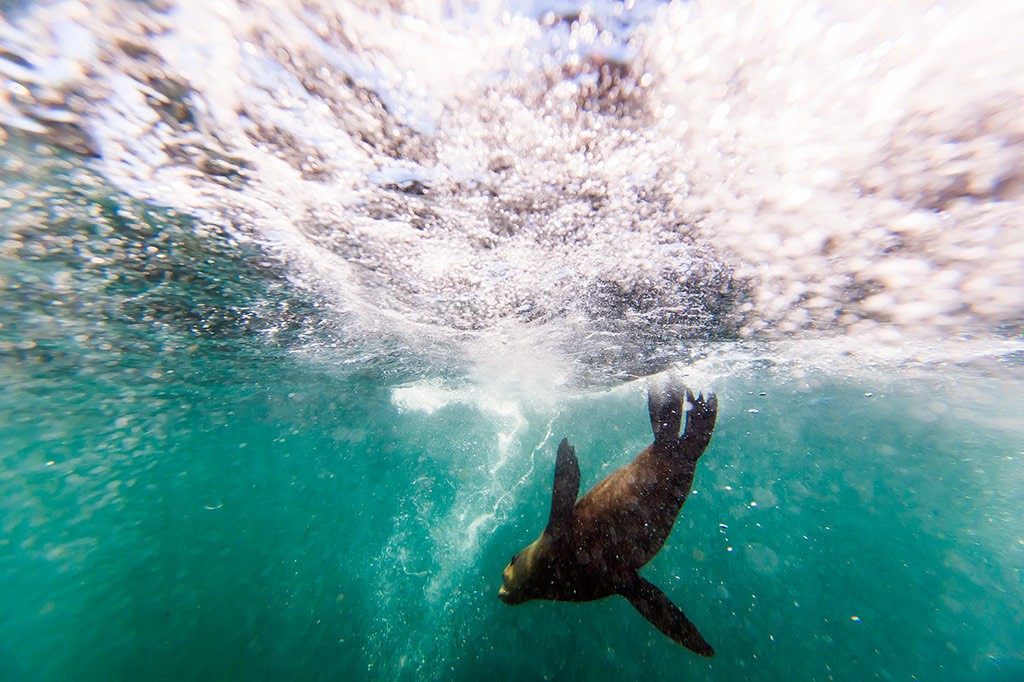
Photo by Teagan Cunniffe.
Being a landlocked Joburger, I’ve been longing for the sea like a lovesick teenager and have bragged to anyone who cared (or didn’t) about my Animal Ocean adventure. Unlike shark-cage diving or swimming with dolphins, seal snorkelling is fairly off the radar for many South African bucket-listers and few people know about this affordable excursion. Despite this, everyone’s an expert.
‘You’re going to get chomped,’ says my mom. ‘Isn’t that where they take those incredible photographs of sharks leaping out the water?’ says my colleague. ‘So you’re basically going to be swimming in shark feed,’ says my boyfriend. I won’t fib. When I pulled on the black diving suit and looked down, the similarity to an easy meal was uncanny.
In 20 years of operation none of the seal-watching boats, which transport tourists to Duiker Island, have reported shark sightings. The island is surrounded by shallow waters, averaging about five-metres in depth, and covered in thick kelp forests, hampering visibility and speed, both of which sharks need to feed. The water is also colder than that of the south peninsula and ranges between 10°C and 14°C.
Reassured, only the water bites sharply as I slip off the Animal Ocean and dip my face beneath the waves. The seals are skittish at first, spinning away from me in a whoosh of bubbles. They’re unbelievably fast. There are bubbles everywhere and an astonishing number of animals. Their eyes are enormous, fully open to make the most of the light penetrating the water. After a few minutes I get the hang of blowing water from my snorkel and the cold quickly gives way to delight as I start to relax in the water.
Watch the GoPro footage here
Steve Benjamin, owner of Animal Ocean marine adventures, is a trained zoologist, marine guide, skipper, scientific commercial diver and giver of good advice. He suggested I keep to the edge of the snorkel group because the seals tend to be more playful on the sidelines. I hover over the yellow kelp forest, absorbed by a pair of these extraordinary mammals floating below me. Suddenly, I feel a tug on my fin and look at my feet. Nothing. But I could have sworn I felt… Out of the blue (quite literally) in an eruption of froth, I’m dive-bombed right between the eyes by a frisky seal. It swims right up to my mask before veering sharply to my right, narrowly avoiding a collision. Before I can recover, it happens again and then it stops within an arms length, its big eyes taking stock of my reaction. I gaze back, braced in anticipation for another dart. But, with head cocked and tail up, the animal executes a balletic twirl, swoops below my fins and disappears.
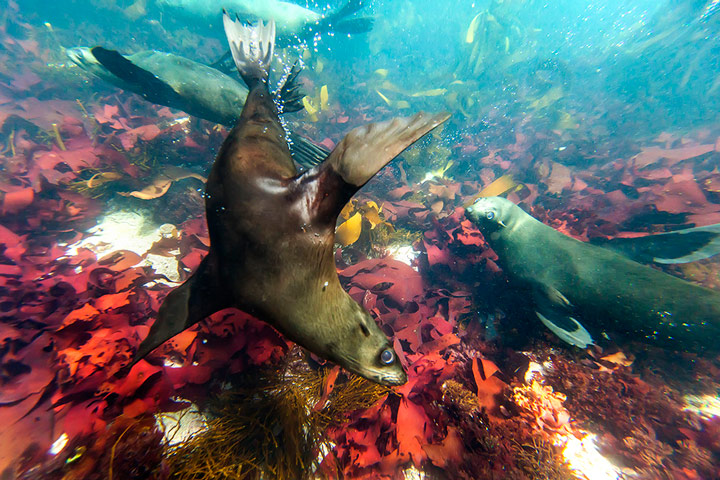
Photo by Teagan Cunniffe.
These agile animals are capable of reaching 28 kilometres per hour. Seals spend a majority of their life at sea, feeding and skipping over waves, although pups spend their first six months on land before taking to the water to learn hunting skills. Their highly sensitive whiskers give them an advantage when a meal is near because they can detect tiny vibrations made by fish swimming up to two metres away. Years of rehearsal in the water make dive-bombing fin-clad humans a cinch.
After an hour in the water it’s all over. I’m hauled onto the boat where warm water and hot chocolate is waiting. The former is poured over my hands and down my suit (the very definition of elation after 60 minutes in the icy Atlantic) and the latter down my gullet, followed by a biscuit.
Snorkelling with Cape Fur seals is an experience of a lifetime. As far as animal experiences go, this is remarkable – and you’re guaranteed that these comical playmates will come to the party. Don’t let their dubious toilet habits put you off.
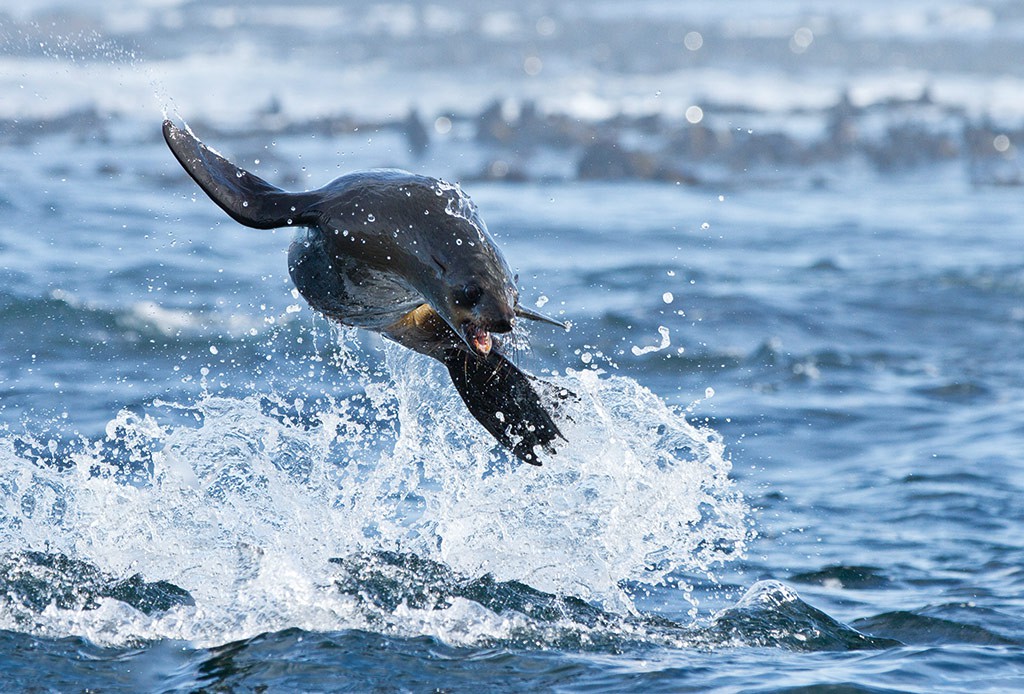
Photo by Steve Benjamin.
Getting there
The Animal Ocean seal snorkelling vessel departs at 10am and 12pm, in September, October and April, and at 9am and 12pm from November to March. It leaves from the NSRI building in Hout Bay harbour, about 20 kilometres from Cape Town’s city centre. You can buy a R160 day pass to use the City Sightseeing hop-on hop-off bus, which operates to Hout Bay and around the peninsula.
When to go
Seal snorkelling conditions are most conducive (and warm) between December and February. Snorkelling during mid-March and April is also good as the seal pups take to water for the first time and play in the waves. There are about 10000 seals on the island.
Pack
Bring your towel and a waterproof camera. There is a restaurant to change in nearby or you can use one of the boat’s ponchos to protect your modesty, but best to arrive ready to swim.
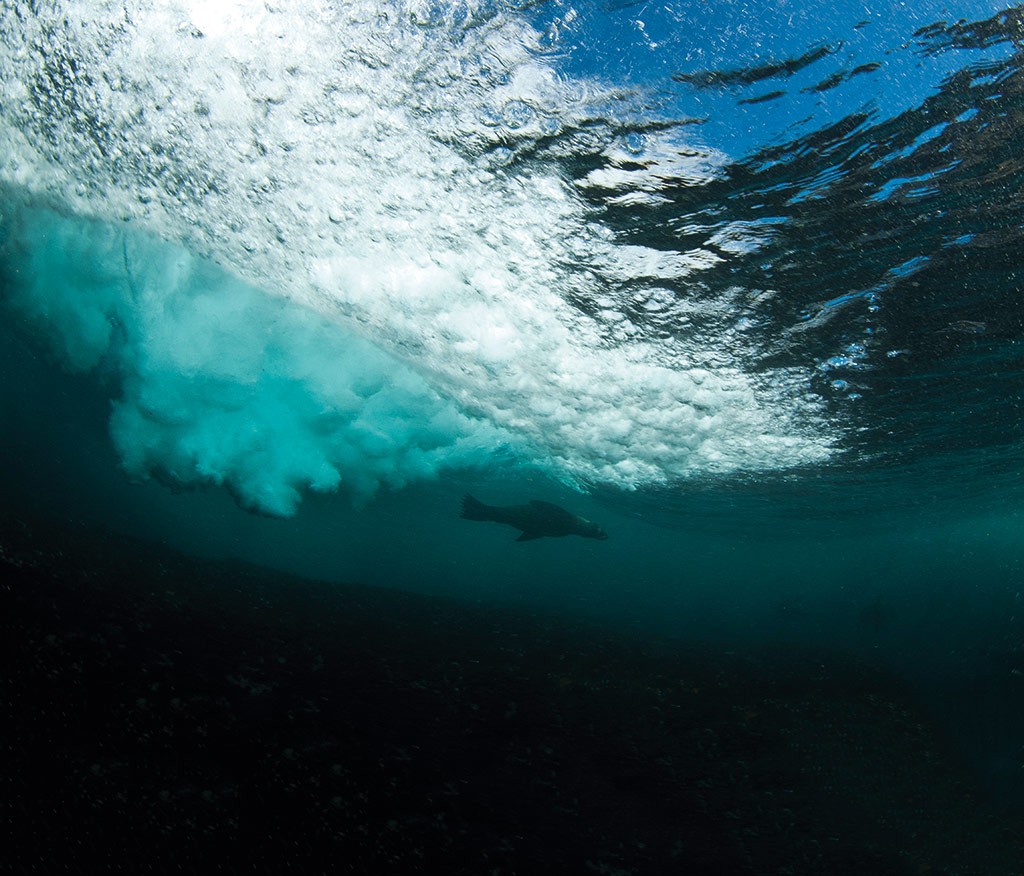
Photo by Steve Benjamin.
Need to know
The trip takes three hours and includes kitting up, a safety briefing, the boat ride from Hout Bay to Duiker Island and an hour in the water. If you’re prone to seasickness take precautions. The boat ride is easy and no one got ill on my trip, but it depends on sea conditions and the individual. Book in advance as each trip consists of no more than 10 snorkelers and no children under six years old.
Cost
The seal snorkelling experience costs R650 per person, including snacks, refreshments, wetsuit and snorkelling gear hire, a professional dive master and the boat trip to Duiker Island. If you can afford it, hire a GoPro from R200 a person to take the memory home.
Do this
Browse the Hout Bay market before or after your swim. There are curios, fabrics, clothes and other bits and pieces for sale. The harbour is picturesque, with coloured boats and a mountain backdrop for photo opportunities. Be aware that if you take photos of the seals in the harbour, they are lured there by local fishermen who expect payment.
Eat here
The Mariner’s Wharf at Hout Bay harbour serves good seafood and fish and chips – and after an hour in the water, nothing goes down better. Try the crumbed calamari, and pop next door to the Fisherman’s Wharf Market to check out sushi and fresh fish.
The Lookout Deck is set behind the facade of an old lighthouse, so it’s easy to miss it from Hout Bay’s Harbour Road. That would be a mistake. With everything from seafood and sushi to wood-fired pizza, there is something to suit every taste. The view across the bay towards Chapman’s Peak is spectacular. Sip sundowners on the deck and watch the harbour activity. If you’re staying for dinner, try the seared tuna, best served rare.
This article first appeared in the February 2015 issue of Getaway magazine.
All prices were correct at time of publication, but are subject to change at each establishment’s discretion. Please check with them before travelling.
